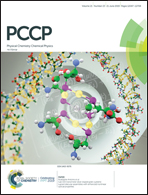Strategies for the analysis of the elemental metal fraction of Ir and Ru oxides via XRD, XANES, and EXAFS†
Abstract
Iridium and ruthenium oxide are active electrocatalysts for oxygen evolution. The relation between preparation method, structure, and behavior of mixed oxides of iridium and ruthenium are of interest in order to obtain active and stable catalysts. In this work the structure of mixed Ru–Ir oxides synthesized by the polymeric precursor method, which involves the formation of a gel containing the metal precursors and subsequent heat-treatment in air, was studied for the IrxRu1−xO2 system. An in-depth analysis of X-ray diffraction (XRD) and X-ray absorption (XAS) data, including EXAFS and linear combination of XANES, shows that the polymeric precursor synthesis method is capable of providing an intimate mixing of Ir and Ru in the catalyst. In addition to the oxide phase, metal phases, i.e. with Ru or Ir or both in oxidation state zero (Ir(fcc) and Ru(hcp)), were also found in the product materials. Facing complex structures such as some of those synthesized here, we have shown that a representation of shells with more than one atom type are efficiently represented using mixed sites, i.e. including scattering contributions from several elements in a site corresponding to a partial occupancy of the site by these elements, this method forming a very efficient basis for analyzing EXAFS data.

- This article is part of the themed collection: 2019 PCCP HOT Articles


 Please wait while we load your content...
Please wait while we load your content...